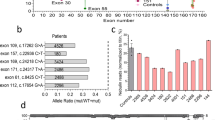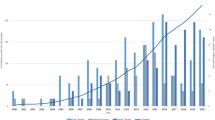Abstract
Multiple acyl-CoA dehydrogenation deficiency (MADD) is an autosomal recessive disease affecting amino acid, fatty acid, and choline metabolisms and is a common genetic defect responsible for lipid storage myopathy. Most forms of MADD are caused by a deficiency of electron transfer flavoprotein (ETF) or ETF dehydrogenase (ETFDH). However, its molecular feature has not been found uniformly in previous reports of Chinese patients. A large cohort of 56 late-onset MADD patients from 51 unrelated pedigrees in southern China was recruited to investigate a clear correlation between clinical phenotype and molecular genetic basis. All exons of ETFA, ETFB, and ETFDH, including the intron–exon boundaries, and 5′ and 3′ untranslated regions were directly sequenced. ETFDH deficiencies affected 94.1% (48/51) of the pedigrees. ETFDH-c.250G>A is the most common mutation, representing a high allelic frequency of 83.3% (80/96). Carrier frequency of c.250G>A is estimated to be 1.35% (7/520) in the normal population. A significant reduced expression of ETFDH was identified in the muscle of ETFDH-deficient patients. ETFDH deficiency is a major cause of riboflavin-responsive MADD in southern China, and c.250G>A is an important mutation that could be employed as a fast and reliable screening method.




Similar content being viewed by others
References
Bruno C, DiMauro S (2008) Lipid storage myopathies. Curr Opin Neurol 21:601–606
Frerman FE, Goodman SI (2001) Defects of electron transfer flavoprotein and electron transfer flavoprotein-ubiquinone oxidoreductase: glutaric acidemia type II. In: Scriver CR, Beaudet AL, Sly WS, Valle D (eds) The metabolic and molecular bases of inherited diseases, 8th edn. McGraw-Hill, New York, pp 2357–2365
Rhead W, Roettger V, Marshall T, Amendt B (1993) Multiple acyl-coenzyme A dehydrogenation disorder responsive to riboflavin: substrate oxidation, flavin metabolism, and flavoenzyme activities in fibroblasts. Pediatr Res 33:129–135
Vergani L, Barile M, Angelini C, Burlina AB, Nijtmans L, Freda MP, Brizio C, Zerbetto E, Dabbeni-Sala F (1999) Riboflavin therapy: biochemical heterogeneity in two adult lipid storage myopathies. Brain 122:2401–2411
Schiff M, Froissart R, Olsen RK, Acquaviva C, Vianey-Saban C (2006) Electron transfer flavoprotein deficiency: functional and molecular aspects. Mol Genet Metab 88:153–158
Roberts DL, Frerman FE, Kim JJ (1996) Three-dimensional structure of human electron transfer flavoprotein to 2.1-A resolution. Proc Natl Acad Sci USA 93:14355–14360
Simkovic M, Degala GD, Eaton SS, Frerman FE (2002) Expression of human electron transfer flavoprotein-ubiquinone oxidoreductase from a baculovirus vector: kinetic and spectral characterization of the human protein. Biochem J 364:659–667
Finocchiaro G, Ito M, Ikeda Y, Tanaka K (1988) Molecular cloning and nucleotide sequence of cDNAs encoding the alpha-subunit of human electron transfer flavoprotein. J Biol Chem 263:15773–15780
Finocchiaro G, Colombo I, Garavaglia B, Gellera C, Valdmeri G, Garbuglio N, Didonato S (1993) cDNA cloning and mitochondrial import of the beta-subunit of the human electron-transfer flavoprotein. Eur J Biochem 213:1003–1008
Goodman SI, Axtell KM, Bindoff LA, Beard SE, Gill RE, Frerman FE (1994) Molecular cloning and expression of a cDNA encoding human electron transfer flavoprotein-ubiquinone oxidoreductase. Eur J Biochem 219:277–286
Goodman SI, Binard R, Woontner M, Frerman FE (2002) Glutaric acidemia type II gene structure and mutations of the electron transfer flavoprotein-ubiquinone oxidoreductase (ETF QO) gene. Mol Genet Metab 77:86–90
Olsen RK, Andresen BS, Christensen E, Bross P, Skovby F, Gregersen N (2003) Clear relationship between ETF/ETFDH genotype and phenotype in patients with multiple acyl-CoA dehydrogenation deficiency. Hum Mutat 22:12–23
McKean MC, Beckmann JD, Frerman FE (1983) Subunit structure of electron transfer flavoprotein. J Biol Chem 258:1866–1870
Olsen RK, Olpin SE, Andresen BS, Miedzybrodzka ZH, Pourfarzam M, Merinero B, Frerman FE, Beresford MW, Dean JC, Cornelius N et al (2007) ETFDH mutation as a major cause of riboflavin-responsive multiple acyl-CoA dehydrogenation deficiency. Brain 130:2045–2054
Gempel K, Topaloglu H, Talim B, Schneiderat P, Schoser BG, Hans VH, Pálmafy B, Kale G, Tokatli A, Quinzii C et al (2007) The myopathic form of coenzyme Q10 deficiency is caused by mutations in the electron-transferring-flavoprotein dehydrogenase (ETFDH) gene. Brain 130:2037–2044
Yotsumoto Y, Hasegawa Y, Fukuda S, Kobayashi H, Endo M, Fukao T, Yamaguchi S (2008) Clinical and molecular investigations of Japanese cases of glutaric acidemia type 2. Mol Genet Metab 94:61–67
Wen B, Dai T, Li W, Zhao Y, Liu S, Zhang C, Li H, Wu J, Li D, Yan C (2010) Riboflavin responsive lipid storage myopathy caused by ETFDH gene mutations. J Neurol Neurosurg Psychiatry 81:231–236
Liang WC, Ohkuma A, Hayashi YK, López LC, Hirano M, Nonaka I, Noguchi S, Chen LH, Jong YJ, Nishino I (2009) ETFDH mutations, CoQ10 levels, and respiratory chain activities in patients with riboflavin-responsive multiple acyl-CoA dehydrogenase deficiency. Neuromuscul Disord 19:212–216
Law LK, Tang NL, Hui J, Fung SL, Ruiter J, Wanders RJ, Fok TF, Lam CW (2009) Novel mutations in ETFDH gene in Chinese patients with riboflavin-responsive multiple acyl-CoA dehydrogenase deficiency. Clin Chim Acta 404:95–99
Er TK, Liang WC, Chang JG, Jong YJ (2010) High resolution melting analysis facilitates mutation screening of ETFDH gene: applications in riboflavin-responsive multiple acyl-CoA dehydrogenase deficiency. Clin Chim Acta 411:690–699
Lan MY, Fu MH, Liu YF, Huang CC, Chang YY, Liu JS, Peng CH, Chen SS (2010) High frequency of ETFDH c.250G>A mutation in Taiwanese patients with late-onset lipid storage myopathy. Clin Genet 78:565–569. doi:10.1111/j.1399-0004.2010.01421.x
Przyrombel H, Wendel U, Becker K, Bremer HJ, Bruinvis L, Ketting D, Wadman SK (1976) Glutaric aciduria type II: report on a previously undescribed metabolic disorder. Clin Chim Acta 66:227–239
Kimura M, Yoon HR, Wasant P, Takahashi Y, Yamaguchi S (2002) A sensitive and simplified method to analyze free fatty acids in children with mitochondrial beta oxidation disorders using gas chromatography/mass spectrometry and dried blood spots. Clin Chim Acta 316:117–121
Wu ZY, Zhao GX, Chen WJ, Wang N, Wan B, Lin MT, Murong SX, Yu L (2006) Mutation analysis of 218 Chinese patients with Wilson disease revealed no correlation between the canine copper toxicosis gene MURR1 and Wilson disease. J Mol Med 84:438–442
Ng PC, Henikoff S (2003) SIFT: predicting amino acid changes that affect protein function. Nucleic Acids Res 31:3812–3814
Zhang J, Frerman FE, Kim JJ (2006) Structure of electron transfer flavoprotein-ubiquinone oxidoreductase and electron transfer to the mitochondrial ubiquinone pool. Proc Natl Acad Sci USA 103:16212–16217
Colombo I, Finocchiaro G, Garavaglia B, Garbuglio N, Yamaguchi S, Frerman FE, Berra B, DiDonato S (1994) Mutations and polymorphisms of the gene encoding the beta-subunit of the electron transfer flavoprotein in three patients with glutaric acidemia type II. Hum Mol Genet 3:429–435
Nagao M, Tanaka K (1992) FAD-dependent regulation of transcription, translation, post-translational processing, and post-processing stability of various mitochondrial acyl-CoA dehydrogenases and of electron transfer flavoprotein and the site of holoenzyme formation. J Biol Chem 267:17925–1732
Muralidhara BK, Rathinakumar R, Wittung-Stafshede P (2006) Folding of Desulfovibrio desulfuricans flavodoxin is accelerated by cofactor fly-casting. Arch Biochem Biophys 451:51–58
Acknowledgments
The authors sincerely thank the participants for their help and willingness to participate in this study and the anonymous reviewers for helping to improve this manuscript.
Funding/support
This work was supported by a key program of scientific research of Fujian Medical University (2009D064), a program for Innovative Research Teams in Science (FMU-RT002), Fuzhou, and a grant from Huashan Hospital for the special professorship of Fudan University, Shanghai (to Wu ZY), China.
Financial disclosure statement
The authors declare that they have no conflicts of interest.
Author information
Authors and Affiliations
Corresponding author
Electronic supplementary material
Below is the link to the electronic supplementary material.
Supplementary Fig. 1
Muscle biopsy of a patient with MADD showing common histological and electron microscopy findings. a Hematoxylin and eosin stain showed moderate to severe vacuolar myopathy. b ATPase stain (pH 4.6) revealed that the vacuolar change was most prominent in type-I fibers. c ORO stain showed lipid accumulation in type-I fibers. d There was a marked increase in the amount of lipid deposited within the myofibers. A′, B′, C′, and D′ represented the boxed region in A, B, C, D at a higher magnification (JPEG 1315 kb)
Supplementary Fig. 2
Four known mutations including c.250G>A (p.Ala84Thr), c.524G>A (p.Arg175His), c.770A>G (p.Tyr257Cys), and c.1395T>G (p.Tyr465X) in ETFDH. The upper panel for each chromatogram depicts the normal sequence, whereas the lower panel represents mutated sequence (JPEG 1251 kb)
Supplementary Fig. 3
Primer mismatch PCR-RFLP analysis of c.770A>G, c.998A>G, and c.1395T>G mutations. Left: Analysis of the c.770A>G mutation. After cleavage with RsaI, the allele with c.770A>G was cut into 156-bp and 20-bp fragments, whereas the normal allele was not cut. 1–3 Patients with compound heterozygous mutations of c.[250G>A]+[770A>G], c.[524G>A]+[770A>G], c.[770A>G]+[1254_1257del], respectively. 4-5 Normal controls. Middle: Analysis of the c.998A>G mutation. After cleavage with MaeII (or TaiI), the normal allele was cut into 106-bp and 24-bp fragments, whereas the allele with c.998A>G was not cut. 1-2 Two patients with compound heterozygous mutations of c.[250G>A]+[998A>G]. 3–5 Normal controls. Right: Analysis of the c.1395T>G mutation. After cleavage with Csp68III, the normal allele was cut into 115-bp and 20-bp fragments, whereas the allele with c.1395T>G was not cut. 1 Patient with a single heterozygous of c.[1395T>G]+[?]. 2–5 Normal controls. M DL2000 marker (JPEG 383 kb)
Supplementary Table
Primers designed for ETFA, ETFB, ETFDH, and PCR conditions (DOC 78 kb)
Rights and permissions
About this article
Cite this article
Wang, ZQ., Chen, XJ., Murong, SX. et al. Molecular analysis of 51 unrelated pedigrees with late-onset multiple acyl-CoA dehydrogenation deficiency (MADD) in southern China confirmed the most common ETFDH mutation and high carrier frequency of c.250G>A. J Mol Med 89, 569–576 (2011). https://doi.org/10.1007/s00109-011-0725-7
Received:
Revised:
Accepted:
Published:
Issue Date:
DOI: https://doi.org/10.1007/s00109-011-0725-7




